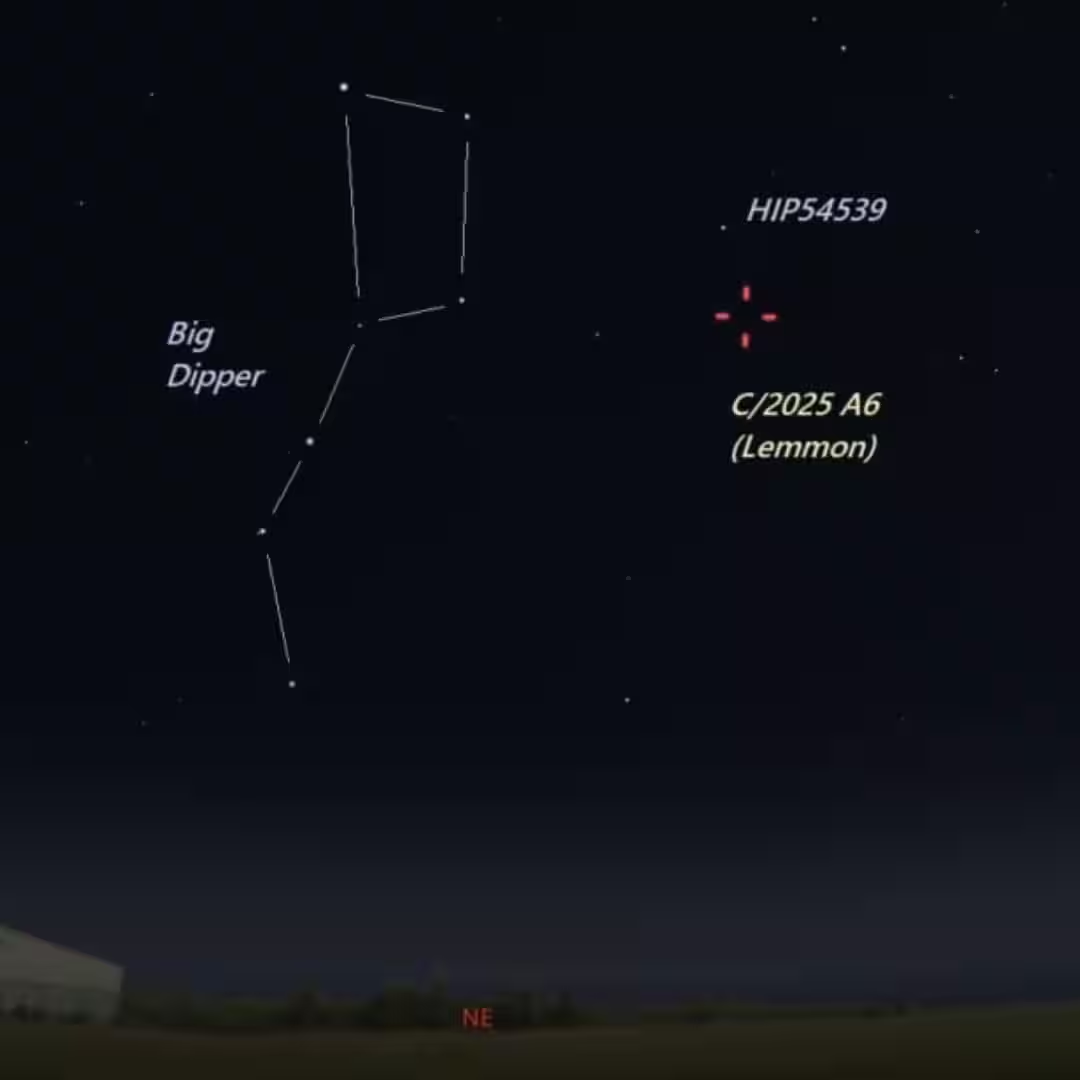Spotlight on Three Comets: Lemmon, SWAN, and ATLAS — What to Watch in 2025

Astronomy buffs, prepare for one of the most exciting comet seasons in recent years. Three comets — C/2025 A6 (Lemmon), C/2025 R2 (SWAN), and C/2025 K1 (ATLAS) — are making headlines for their predicted brightness, orbits, and viewing potential. This post brings you the latest on each, plus tips on when and how to see them.
Discovery & Orbit
- Discovered on January 3, 2025 by the Mount Lemmon Survey as an apparently asteroidal object. Wikipedia+2British Astronomical Association+2
- Precovery images from November 2024 confirmed its cometary nature. British Astronomical Association+3Wikipedia+3Aerith+3
- Orbital parameters: perihelion (closest to Sun) at 0.5299 AU, high eccentricity (~0.9957), and a long orbital period (~1,350 years inbound, ~1,155 years outbound). British Astronomical Association+3Wikipedia+3COBS+3
Brightness & Visibility
- The comet has already brightened more than originally expected. Some models now predict a peak brightness of magnitude ~4, possibly making it visible to the naked eye in dark skies. Unistellar Science+3Star Walk+3Space+3
- It will make its closest approach to Earth on October 21, 2025, at about 0.596 AU (≈ 89 million km) TheSkyLive+2Space+2
- It reaches perihelion on November 8, 2025. Unistellar Science+4Wikipedia+4Aerith+4
- In late September, it is located in the constellation of Lynx, rising early and visible before dawn in many northern locations. Astro Van Buitenen+3TheSkyLive+3Star Walk+3
- Some charts suggest by late October it could be circumpolar at latitudes above ~48° N (meaning it never sets below the horizon). Star Walk+2Space+2
Observing Tips
- For best view, use binoculars or a mid-sized telescope early in the morning when the sky is darkest and the comet is highest.
- Use star charts or apps (e.g. Stellarium) to track its path through constellations: Lynx → Leo Minor → Ursa Major → Canes Venatici etc. Star Walk+2Space+2
- Since comets are unpredictable, monitoring images and magnitude reports from observer networks (e.g., COBS, AERITH) is helpful. Unistellar Science+4COBS+4Aerith+4
2. Comet C/2025 R2 (SWAN)
Discovery & Characteristics
- Discovered on September 11, 2025, via the SWAN instrument aboard the SOHO spacecraft by Vladimir Bezugly. Wikipedia+2Space+2
- Its orbit is highly elongated (long-period comet), and initial observations place it at magnitude ~6.0. Wikipedia+2TheSkyLive+2
Brightness & Visibility
- The comet is becoming more visible, with reports noting a greenish coma and tail captured in recent telescopic images (September 17). EarthSky+1
- Some forecasts suggest it may brighten sufficiently to become visible to binoculars or even the naked eye by October (if predictions hold). Space+1
- It will pass relatively close to Earth, with its closest approach projected near 0.2606 AU (~38.99 million km) on October 20. TheSkyLive
Observing Tips
- Because it lies closer to the Sun’s direction in the sky, visibility will be tricky against twilight glare — early evening or pre-dawn windows may help.
- Use telescopes or long-exposure photography to reveal the green coma and faint tail.
- Sky mapping tools (e.g. TheSkyLive) provide updated ephemerides (right ascension, declination, rise/set times) to help track its path. TheSkyLive
3. Comet C/2025 K1 (ATLAS)
Discovery & Behavior
- C/2025 K1 (ATLAS) is currently less documented in mainstream sources, but it is part of the comet lineup for late 2025. SETI Institute
- It passed perihelion on October 8, 2025 (closest to Sun). SETI Institute
- Observers note a lack of a clear ion tail, possibly due to depletion in volatile materials like carbon. Facebook
Observing Potential
- Post-perihelion, the comet’s survival is not guaranteed — comets often disintegrate during close solar passes. SETI Institute
- Its closest approach to Earth is projected for November 26, 2025, making November a critical observation period. SETI Institute
What Makes This Season Special
- According to LiveScience, two comets (Lemmon and SWAN) may become visible in the same night, coinciding with the peak of the Orionid meteor shower (October 20–21). Live Science
- October 21 also features a new moon, reducing moonlight and improving dark-sky conditions for observing faint comets. Live Science+1
- This could mark a rare occasion where bright comets and meteor activity line up, offering observers a spectacular celestial show. Live Science
==> How to Track These Comets Using Stellarium & Apps
https://theskylive.com/planetarium?obj=c2025a6#ra|9.292640143717332|dec|38.650243619643014|fov|80
- Add by designation: In Stellarium, use “Comet” mode and enter the comet’s name or designation (e.g., “C/2025 A6”).
- Update ephemeris: In extended settings, use an orbital file (e.g. from NASA/JPL or Minor Planet Center) so Stellarium knows its path precisely.
- Switch to “All Models” view: This lets you see faint objects — adjust magnitude limits.
- Set observing location & time: Match your local coordinates and date/time to see where and when the comet will rise/set.
- Use zoom and field-of-view (FoV) presets: You can compare the comet’s location against known star fields to help find it in real sky observations.
Quick Summary Table
| Comet | Closest Approach Date | Predicted Brightness | Viewing Window | Key Notes |
|---|---|---|---|---|
| C/2025 A6 (Lemmon) | 21 October 2025 | ~ magnitude 4 (optimistic) | Late October to early November | Best visibility in Northern Hemisphere; may become circumpolar above ~48° N Aerith+4Star Walk+4Space+4 |
| C/2025 R2 (SWAN) | 20 October 2025 | ~ magnitude 6 → possibly brighter | October | Green coma visible; good candidate binocular object TheSkyLive+2EarthSky+2 |
| C/2025 K1 (ATLAS) | 26 November 2025 | Unknown / uncertain | November | Survival post-perihelion uncertain; limited data SETI Institute |
Final Notes & Advice
- These comets’ brightness predictions are not guarantees — comets are notoriously unpredictable.
- Use dark skies, binoculars, or telescopes.
- Combine your comet viewing with meteor showers (especially in mid-October) for a richer sky experience.
- Stay updated with comet tracking services (COBS, TheSkyLive, AERITH) for magnitude updates and orbital refinements.


Excited to see 😍
It was so fun to read but these line breaks and now even emojis!.. so chat gpt
Such a turn off 😑
Idc… At least am getting news in the perfect and standard ways and not hopin between this or that… Am still enjoying it🥹✨
Wonderful!!!
Exited😍
The jilipgapp seems pretty legit so far. Downloaded and ready to play, hoping to get a good start there. Let’s see it worth it! jilipgapp
Just a heads up, guys, I played on taya3659 and the mobile experience was surprisingly smooth. Perfect for betting on the go. Worth it for that alone! Try it here: taya3659
I gotta say, ip88okvip surprised me. Their customer support replies really fast and are helpful. Some sites leave you hanging forever. Good selection of live casino games too. Definitely a positive experience. Go check out ip88okvip.
Fyyobe? Okay, I’ve given it a whirl. Lots of game choices, which is awesome. Needs a little polish in the customer service department, just saying. Give it a look: fyyobe
Demopgslot é top pra quem quer treinar antes de apostar de verdade! Dá pra testar os jogos sem gastar nada. Ótima dica pra iniciantes! 😉 demopgslot